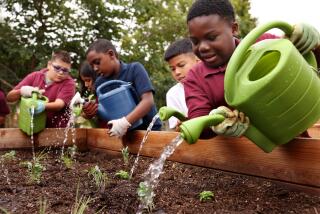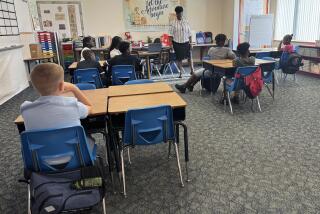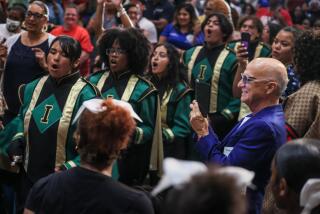BUENA PARK : State-of-the-Art Facilities at School
- Share via
The new Centralia School was built for high-tech teaching and learning.
“We started with our vision of what we wanted for our children by taking a look at research and future trends for education,” Principal Linda Rader said.
That vision turned into an elementary school designed for the 21st Century.
The $5.5-million school at 195 N. Western Ave. in Anaheim opened on Aug. 9 with an enrollment of 576 students.
Centralia, which serves students in kindergarten through sixth grade who live in Buena Park and Anaheim, is the first school in the Centralia School District to offer a year-round curriculum.
The school is at the same eight-acre site of the original Centralia School built in 1936 but closed in 1981 because of declining enrollment.
In the late 1980s, Centralia district officials decided to raze the old school and build a modern facility. A design committee included Rader, teachers, board members, district employees and parents.
Parent Kathie Poston, the school’s health clerk and co-chair of the committee, said everyone agreed that the facility should be a school of the future.
“We have designed the media center and computer lab so it is all centralized into one learning complex,” Rader said. “And that’s the hub of the school.”
Each classroom also has been wired for computers, television, VCRs and laser disc players.
In the future, the school will operate a video network to broadcast instruction from one classroom to another.
The 18 new classrooms are divided into three clusters, in which six classrooms share a common study area.
The classrooms feed into the central “learning hub” so there is immediate access to the resources that will be housed in those areas, Rader said.
Two new kindergarten classrooms are in a separate building with an enclosed playground.
Second-grade teacher Karla Wells, also on the committee, said that another important design feature for the new school is the openness of the building.
“We wanted lots of windows and plants--we felt it should be homey and not an industrial place,” Wells said.
The classrooms have movable walls to encourage team teaching, in which classes can be combined for instruction and learning activities.
Rafael Santiago, a sixth-grade teacher, said the school’s design opens up a whole new learning world for students as well as their teachers.
“It’s a lot of fun to get to know another class of kids other than your own,” Santiago said.
“The design itself makes you feel that you’re one school--you get that community feeling.”
More to Read
Sign up for Essential California
The most important California stories and recommendations in your inbox every morning.
You may occasionally receive promotional content from the Los Angeles Times.










